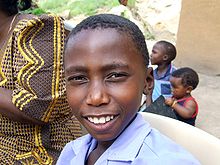- Bassoutos
-
Basotho
Basotho 
Écolier Basotho Populations significatives par régions  Afrique du Sud
Afrique du Sud3 543 000  Lesotho
Lesotho1 600 000  Botswana
Botswana9 900  Swaziland
Swaziland5 400 Population totale 5 158 000 Langue(s) Religion(s) Les Basotho (ou Sotho, Basuto, Bassouto, Betjouanas), du nom de leur tribu principale, peuple de la famille des Cafres, vivent au Lesotho en Afrique méridionale, entre 19° et 27° latitude sud, dans la Cafrerie intérieure, depuis le XVe siècle. La nation Basotho (habitant le Lesotho moderne) émergea de la diplomatie de Moshoeshoe Ier qui réunit des clans disparates d'origine Sotho qui avaient été dispersés au cours du début du XIXe siècle. Leur pays a été vu la première fois en 1801 par les Anglais Trutter et Somerville.
La majeure partie des Basotho vit en Afrique australe. On distingue les Basotho (parlant le sotho du Sud, au Lesotho) des Tswana (parlant le sotho de l'Ouest, au Swaziland) et des Sothos habitant les provinces du Nord de l'Afrique du Sud (Gauteng, Limpopo et Mpumalanga parlant le sotho du Nord).
Les Basotho élèvent des bêtes à cornes, préparent les peaux et l'ivoire.
Sommaire
Ethnonyme
Le singulier de Basotho est Mosotho (respectivement Bassouto et Massouto). Les Basotho sont aussi désignés sous le nom de Sotho.
Langues
Notes
Source
- Cet article comprend des extraits du Dictionnaire Bouillet. Il est possible de supprimer cette indication, si le texte reflète le savoir actuel sur ce thème, si les sources sont citées, s'il satisfait aux exigences linguistiques actuelles et s'il ne contient pas de propos qui vont à l'encontre des règles de neutralité de Wikipédia.
Voir aussi
Articles connexes
Bibliographie
- (en) Dan Bosko, Social organizational aspects of religious change among Basotho, New York University, 1983, 356 p. (thèse)
- (en) David Bellin Coplan, In the time of cannibals : the word music of South Africa's Basotho migrants, University of Chicago Press, Chicago, 1994, 300 p. (ISBN 0226115747)
- (en) J. Dreyer, « The Basotho hut : from Late Iron Age to present », in South African journal of ethnology, 16 (3), septembre 1993, p. 79-86
- (en) Jeff Guy et Motlatsi Thabane, « Basotho miners, oral history and worker's strategies », in Preben Kaarsholm (dir.), Cultural struggle and development in Southern Africa, Baobab Books, Harare ; James Currey, Londres ; Heinemann, Portsmouth, NH, 1991, p. 239-258
- (en) Myrtle Karstel, The Basotho blanket : borrowed but traditional, National Museum, Bloemfontein, 1995, p. 194-223 (ISBN 1868470121)
- (en) Daniel P. Kunene, Heroic poetry of the Basotho, Clarendon Press, Oxford, 1971, 203 p. (ISBN 0198151322)
- (en) Thomas Lesaoana Manyeli, « Religious symbols of the Basotho », in Mazenod Printing Works, Mazenod (Lesotho), 1992, 133 p.
- (en) Sindile Adelgisa Moitse, The ethno-musicology of the Basotho : a study of the entrenchment of music in Sotho cultural institutions, Institute of Southern African Studies, National University of Lesotho, Roma (Lesotho), 1990, 90 p. (bilingue)
- (en) 'Makali Isabella Mokitimi, « Praise poetry : praise poetry of the Basotho », in Philip M. Peek, African folklore: an encyclopedia, Routledge, New York, 2004, p. 360-361
- (en) Hedley Sleath, A decade with the Basotho, Dept. of Public Relations and Communication of the Methodist Church of Southern Africa in co-operation with the Board of the Semonkong Methodist Hospital, Johannesburg, 1988, 114 p. (ISBN 094745005X)
- (en) Gary Van Wyk, « The mural art of Basotho women (photo essay) », in African arts (Los Angeles), 31 (3), été 1998, p. 58-65
- (en) Gary Van Wyk, African painted houses : Basotho dwellings of Southern Africa, Harry N. Abrams, New York, 1998, 168 p. (ISBN 0810919907)
- (en) Robin E. Wells, An introduction to the music of the Basotho, Morija Museum and Archives, Morija (Lesotho), 1994, 338 p. (ISBN 9991179372)
- (fr) Eugène Arnaud Casalis, Les Bassoutos, ou, Vingt-trois années de séjour et d'observations au sud de l'Afrique, C. Meyrueis et cie, Paris, 1859, 370 p.
- (fr) E. Jacottet, Contes populaires des Bassoutos, Kraus Reprint, Nendeln, 1974 (1re éd. E. Leroux, 1895), 292 p.
- (fr) Claude Hélène Perrot, Les Sotho et les missionaires européens au XIXe siècle, Université d'Abidjan, Abidjan, 1970, 185 p. (Thèse, Paris, 1963)
- (fr) Paul Ramseyer, « La circoncision chez les Bassoutos », in Revue d'ethnographie et des traditions populaires (Paris), 8 (33), 1928, p. 40-70
Liens externes
- Portail de l'anthropologie
- Portail de l’Afrique du Sud
Catégorie : Groupe ethnique d'Afrique du Sud
Wikimedia Foundation. 2010.

